Aeonium: Types, Succulent Care Guide – With Pictures

Aeonium plants are stunning, colorful succulents with thick, fleshy leaves that grow in a rosette pattern. Also called tree houseleeks, the rose-like waxy foliage grows on woody stems. Aeoniums are known for their fascinating colors, and the succulent leaves can be green, red, black, deep purple, yellow, and variegated colors.
This article is a guide to some of the many types of Aeonium succulents you can grow indoors. Pictures and descriptions of these fleshly-leaved plants will help to identify the various species. You will also learn how to care for Aeonium plants.
What Are Aeoniums?

Aeonium is a flowering woody succulent with various colored leaves, depending on the species
Aeonium is a genus of flowering succulents in the family Crassulaceae. There are around 35 species of Aeonium. These succulent plants are identified by their thick, fleshy leaves growing as rosettes. Some Aeonium species have compact leaves that look like rose flowers. Other types of Aeonium have wide, spreading oval to oblong leaves that have the shape of a large saucer.
Like all types of succulents, Aeonium stores moisture in its thick leaves. However, aeoniums have some differences from most succulents. For example, aeoniums have shallow root systems. This type of growth means that the plants can’t grow in soil that dries out completely.
How to Grow Aeoniums
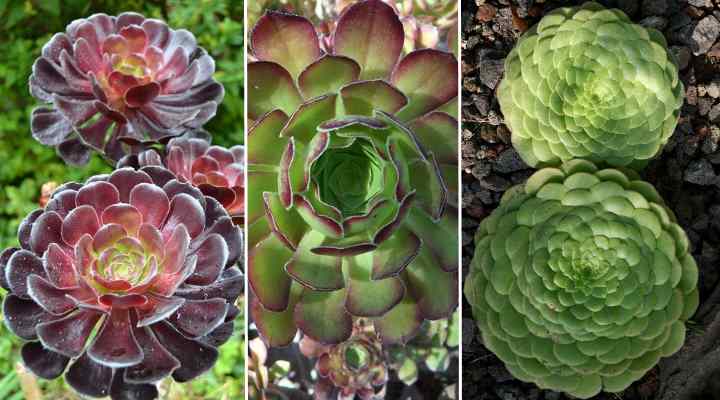
While many succulents prefer dry soil, aeoniums prefer moist soil but not soggy
Aeonium grows in warm, sunny subtropical conditions common to their native habitat of the Canary Islands. Outdoors, many Aeonium species grow as small woody shrubs. These plants thrive in USDA zones 9 through 11 and can’t grow in freezing temperatures. These heat-loving succulents thrive indoors in sunny locations as potted houseplants.
Unlike other types of succulents, Aeoniums grow in the winter through to spring and they are dormant in the summer.
Aeonium plants grow in a temperature range of 40°F to 100°F (4°C – 38°C). Although they can grow in hot weather, they grow best in temperatures between 65°F and 75°F (18°C – 23°C). The succulents grow fastest outdoors in subtropical winter and spring climates. During hot summers, it’s best to keep the plants in partial shade and the soil moist.
Aeoniums are easy to grow from stem and leaf cuttings. All you need to do to produce a new succulent plant is cut off a healthy leaf or stem and let the cutting dry for two days. Then plant the aeonium cutting in moisten peat moss, where it will take root in a few weeks. After the plant is rooted, care for the aeonium plant as usual.
How to Care for Aeoniums Plants
Caring for aeoniums is extremely easy. Grow the succulents in a pot containing loose, porous succulent soil. The best way to care for aeoniums is to water them as often as the top layer of soil dries. Aeoniums grow best in moist potting soil that never becomes soggy or waterlogged.
Growing outdoors, aeoniums need the same care as most succulents. Plant in a sunny spot in your garden that gets six hours of sunshine daily. The ground for aeoniums should be well-draining. So, a rock garden or succulent garden is a perfect growing location where aeoniums can thrive.
Types of Aeoniums (With Pictures)
Let’s look at some of the best types of aeonium succulents to grow at home or in a warm, sunny garden.
Aeonium Arboreum (Tree Aeonium or Irish Rose)
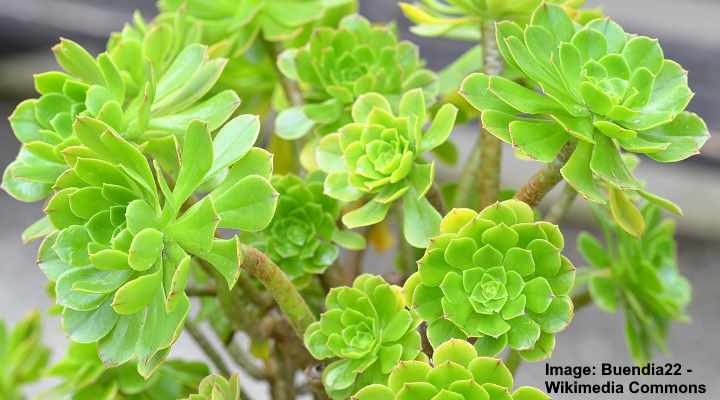
Aeonium arboreum is a shrubby succulent with various cultivars
The Aeonium Arboreum (tree aeonium) is a bushy succulent shrub with waxy foliage that grows large, flattened green rosettes. Tree aeoniums are also called the tree houseleek or Irish rose. The fleshy leaves of this succulent species are obovate or lanceolate shaped that grow between 5” and 15” (12 – 38 cm) long.
Some species of Irish roses have long spatula-like leaves that fan out to create star-shaped rosettes. These leaves turn a dark copper and green color when grown in full sunlight.
Aeonium Arboreum (tree aeonium) has long conical flowers with yellowish-green petals. These fuzzy flower clusters grow 4” to 10” (10 – 25 cm) long and sit on the top of long woody stems. In ideal conditions, the bright yellow flowers bloom in spring.
Tree houseleeks grow outdoors as small multi-stemmed shrubs. You can plant Aeonium arboreum in the ground or containers. The shrubby succulent grows up to 6 ft. (2 m) tall. The fleshy green succulent foliage contrasts with grayish-brown stems.
Aeonium Arboreum ‘Zwartkop’ (Black Rose Succulent)

Aeonium Arboreum ‘Zwartkop’ is also called ‘Black Rose’ and ‘Black Aeonium’
The Aeonium ‘Zwartkop’ is a stunning succulent with large dark burgundy to black fleshy succulent leaves. This large purple aeonium is also called ‘Black Rose’ succulent due to its large black leaves. Other names for this Aeonium succulent are ‘Black Beauty,’ ‘Black Aeonium,’ and ‘Black Head.’
Aeonium arboreum ‘Zwartkop’ has dark foliage in a rosette shape. The elongated spatula leaves are a burgundy to wine red color that are green in the center. The flat spreading rosette can be up to 8” (20 cm) in diameter.
Black Rose multi-branching succulent shrubs grow between 3 and 4 ft. (1 – 1.2 m) tall.
When in bloom, ‘Zwartkop’ aeoniums produce yellowish-white star-shaped flowers. The flower clusters appear in summer and form conical shapes. When not in bloom, this aeonium plant keeps its year-long interest with stunning evergreen colorful foliage.
Aeonium ‘Sunburst’
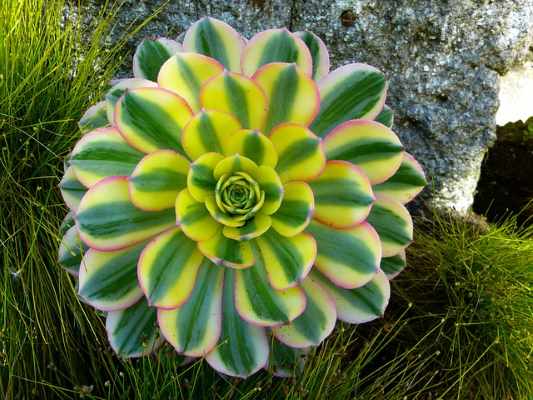
Aeonium ‘Sunburst’ is also called Aeonium ‘Tricolor’ due to its variegated green, yellow and pink leaves
The Aeonium Sunburst is a beautiful succulent with green and yellow obovate leaves that have a hint of pink blush. This variegated aeonium has brightly-colored fleshy foliage in the form of large rosettes growing up to 8” (20 cm) across. The clumps of these spoon-shaped leaves are the reason this succulent-like plant is called Sunburst.
Growing in full sun, the Aeonium ‘Sunburst’ develops coppery red tips. This coloring of the spoon-like leaves adds interest to the variegated bright yellow and green foliage.
Flowers on ‘Sunburst’ aeoniums are clusters of small white starry spring flowers.
‘Sunburst’ aeoniums are small succulent shrubs that grow up to 2 ft. (0.6 m) tall. The thick woody stems have terminal rosettes. Like most aeoniums, the plant’s growth goes dormant in summer. From fall to spring, the plant only needs occasional watering to keep the soil moist.
Aeonium arboreum ‘Atropurpureum’ (Black Tree Aeonium)

‘Atropurpureum’ aeonium cultivar is similar to the ‘Zwartkop’ cultivar but has less dark leaves, with shorter stems and smaller heads
The Black Tree aeonium is a stunning dark-colored succulent with large leafy rosettes. This eye-catching aeonium is also called Purple Rose tree or Dark Purple Houseleek Tree. The dark leaves turn almost black when this aeonium cultivar grows in full sun. The fleshy foliage on this purple aeonium is made from large rosettes.
Purple Rose aeonium flowers are small clusters of star-shaped flowers. The flower clusters grow as large pyramid shapes and are usually bright golden yellow when they bloom in spring.
Aeonium arboreum ‘Atropurpureum’ is a woody shrub-like succulent with multiple stems. The plant grows between 3 and 5 ft. (1 – 1.5 m) tall.
The ‘Atropurpureum’ aeonium is very similar to the ‘Zwartkop’ aeonium. The difference between these two cultivars is that ‘Zwartkop’ aeonium has a very dark foliage with tall arching stems and large heads compared to aeonium ‘Atropurpureum’ which has dark maroon purple foliage with shorter stems and smaller heads.
Aeonium dodrantale (Rose Succulent)
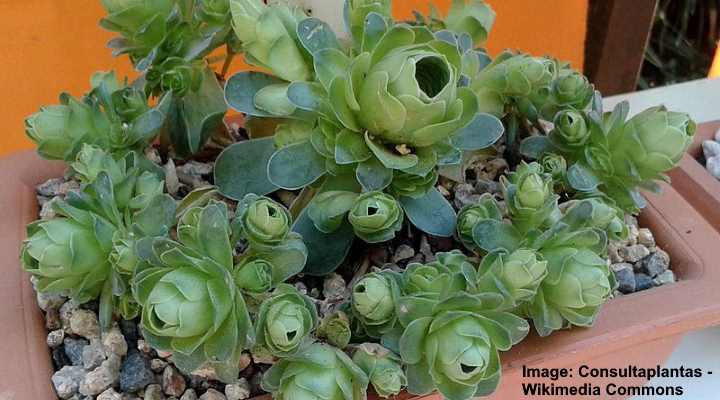
Aeonium dodrantale has a compact growth habit with rose-like heads
The Aeonium dodrantale (rose succulent) is one of the most spectacular succulents with tightly packed rosettes that look like roses. Also called the ‘Mountain Rose’ succulent, Aeonium dodrantale has compact rose-like leaves that are 0.8″ to 1.4″ (2 – 3.5 cm) long. The small rosettes are around 2.4” (6 cm) in diameter.
The other botanical name for rose succulent is Greenovia dodrantalis.
Rose succulents, like all aeoniums, flower in spring and early summer. The fluffy yellow flowers grow on the end of long stalks that are 10” (25 cm) long. These showy flowers contrast nicely with the bluish-green or jade-green foliage.
One of the attractive features of Aeonium dodrantale is its compact growth. This aeonium species is ideal for growing indoors in containers or warm sunny rock gardens.
Aeonium canariense (Canary Island Aeonium)
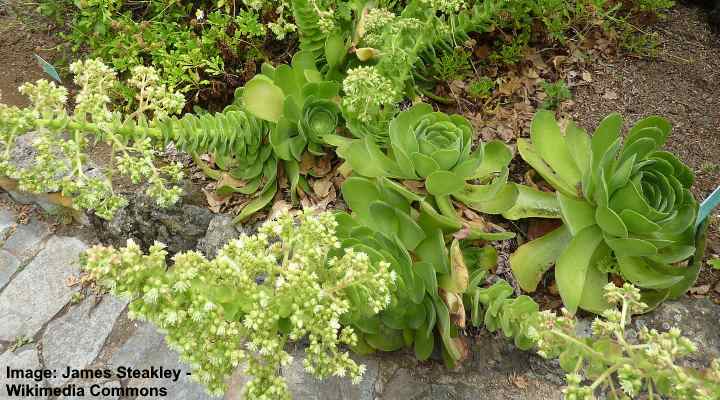
The heads of the Canary Island aeonium are close to the ground but the flower spikes stand up to 2 ft. tall
The Canary Island aeonium is identified by its large fleshy green broad leaves. This sun-loving plant has rosettes that look like artichoke heads. The more sunlight the plant gets, the redder the succulent leaves become. This flowering aeonium produces showy clusters of small star-shaped flowers.
The Aeonium canariense species also goes by the common names ‘Mint Saucer’ aeonium, ‘Giant Velvet Rose,’ and ‘Hens and Chicks’ aeonium.
Canary Island aeoniums are succulent shrubs that form large green rosettes close to the ground. The outstanding feature of Canary Island aeoniums is the large, showy cone-like flower clusters. These clusters of flowers grow at the end of long spikes that can be up to 2 ft. (0.6 m) tall.
Aeonium tabuliforme (Aeonium Dinner Plate)
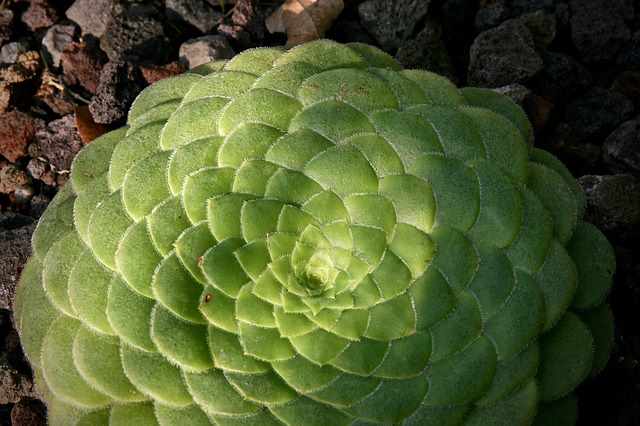
The flat rosette shaped leaves of Aeonium tabuliforme have fuzzy edges
The Aeonium tabuliforme is a flat-topped plant that is aptly named the ‘Aeonium Dinner Plate.’ Other names for this aeonium include ‘Saucer Plant’ and ‘Flat-Topped Aeonium.’ The substantial flat plate-like foliage is made from short, broad, ovate leaves with a fuzzy edge. These overlapping succulent leaves form a spectacular rosette.
An identifying feature of the Aeonium Dinner Plate plant is its low growth. Unlike many species of Aeonium, this is a stemless, low-growing succulent. The Dinner Plate plant only grows between 2” and 6” (5 – 15 cm) tall. However, its wide flat rosettes grow up to 13” (45 cm) wide.
This aeonium has even more interest when it blooms with showy yellow flowers. The large pyramidal flower cluster emerges from the center of the pancake-shaped flat foliage. The flowering stem produces small yellowish, star-shaped flowers.
Aeonium haworthii (Pinwheel Aeonium)

Aeonium haworthii (also called the pinwheel aeonium) is a small flowering succulent shrub with jade green rosettes growing on woody stems. When growing in full sun, the obovate, spoon-like, or diamond-shaped leaves develop red margins. This aeonium’s rosettes grow up to 4” (10 cm) across.
The Aeonium haworthii also has the botanical name Sempervivum haworthii. The common name ‘Pinwheel Aeonium’ refers to the rosette’s shape that resembles a beautiful pinwheel.
Pinwheel aeoniums bloom in spring with showy cream-colored or pinkish flowers. The long flowering stems grow up to 6” (16 cm) long. The end of the stem breaks out into several pendulous flowering stems called peduncles.
The Haworth’s aeonium ‘Variegatum’ is a type of succulent with diamond-shaped leaves with light green, pale yellow and pink colored variegation.
Aeonium percarneum ‘Kiwi’ (Kiwi Aeonium)
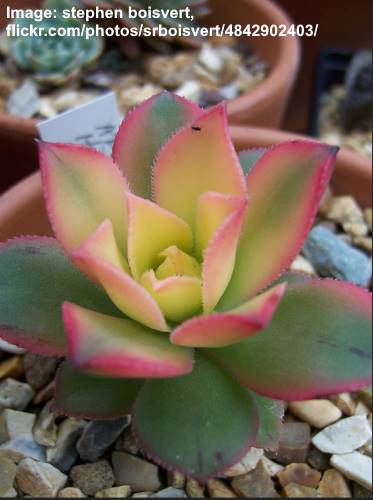
Kiwi aeonium has beautiful variegated leaves with serrated red margins
The Kiwi aeonium is a variegated succulent with green and vibrant red leaves. The individual fleshy leaves are an obovate or triangular shape with serrated margins.
Kiwi aeonium plants growing in bright light have light green and red leaves. Kiwi aeonium plants growing in partial shade have more dramatic coloring. Some plants have three- or four-color variegation.
Kiwi aeonium has stunning colorful rosettes that grow at the end of woody stems. Each variegated rosette grows between 3” and 5” (7 – 12 cm) across. Like most aeoniums, the aeonium percarneum ‘Kiwi’ is a flowering succulent. The plant produces clusters made up of yellow star-shaped flowers on the end of long stems growing out of the rosette center.
Aeonium urbicum (Saucer Plant)
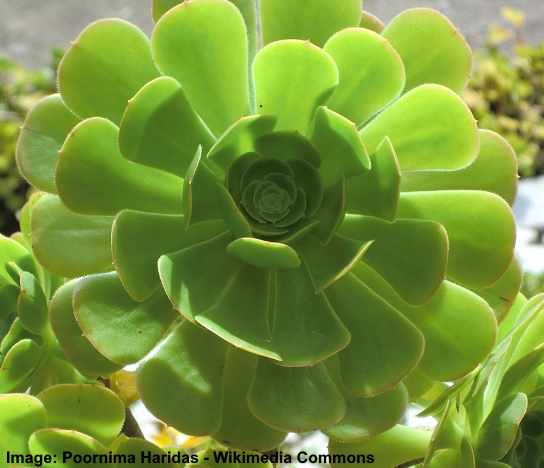
Aeonium urbicum is the largest of the aeonium plants
The saucer plant (aeonium urbicum) is a colossal succulent with a large rosette of smooth green obovate leaves and massive conical flowers. The stunning lime green rosette measures up to 20” (50 cm) across. Growing in full sun, the tips of the spoon-like leaves turn a deep red color.
The Aeonium urbicum (also called Sempervivum urbicum) is the largest of the aeonium plants. The saucer plant succulent grows up to 6 ft. (1.8 m) tall and grows several rosettes.
Another fascinating feature of the aeonium urbicum (saucer plant) is its large flowers. These conical clusters of dainty white or pink flowers can grow up to 3 ft. (1 m) high.
Aeonium Mardi Gras
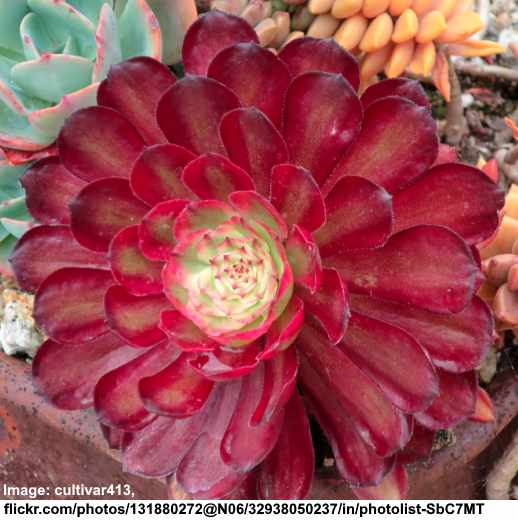
Aeonium mardi gras has a compact growth with stunning red leaves
The Mardi Gras aeonium has a festive look to match its name. This stunning red-leaved succulent has leaves that are a red wine color with a darker stripe in the middle. The center of the large rosette is made from light green pointed leaves to add to the plant’s spectacular look.
Aeonium Mardi Gras plants grow up to 4” (10 cm) tall, and the round spreading rosette is 6” (15 cm) wide.
Other Types of Aeonium Succulents
The beauty of growing species of aeonium plants is the variety of cultivars available. The colorful fleshy leaves, rosette foliage, and showy succulent flowers can brighten up rock gardens, add greenery to patios, or improve any room’s aesthetics. Here are some more aeonium varieties that are worth considering.
Aeonium Nobile — This aeonium has large thick, fleshy leaves that are light green with reddish margins. The rosettes grow up to 15” (38 cm) in diameter. Large orange flat-topped flowers emerge from the rosette’s center.
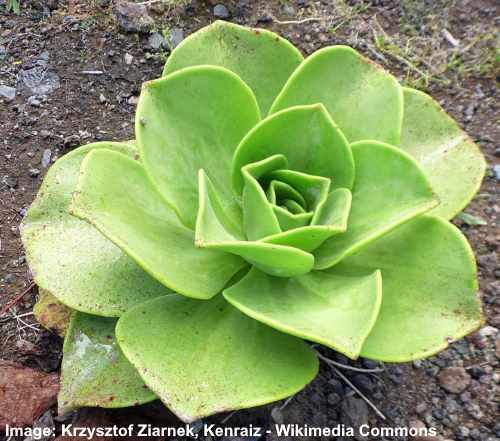
Aeonium Nobile
Aeonium Leucoblepharum — Also called aeonium chrysanthemum, this lovely succulent has light-green pointed obovate leaves with red margins and a red stripe in the middle.
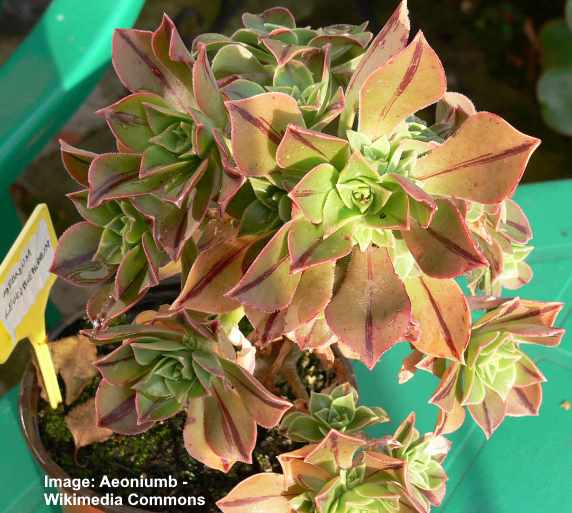
Aeonium Leucoblepharum
Aeonium Cyclops — This aeonium has the common name Giant Red Aeonium. The plant grows a massive rosette that is over 1 ft. (30 cm) across. The variegated aeonium leaves are reddish-bronze with green centers. This hybrid aeonium is a cross between the popular Aeonium arboreum ‘Zwartkop’ and Aeonium undulatum.

Aeonium Cyclops
Aeonium ‘Lily Pad’ — This cute Lily Pad succulent plant has small compact rosettes made up of light yellowish-green triangular fleshy leaves.
Discover other amazing types of succulents.
Read the ultimate guide to caring for succulents and keeping them alive.
Related articles:
- Echeveria Types and How to Care for These Succulents
- Haworthia Plant: Caring for The Cactus Like Succulent
- String of Bananas Succulent: Care and Growing Guide
